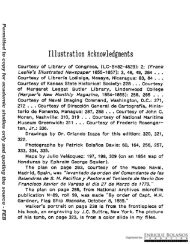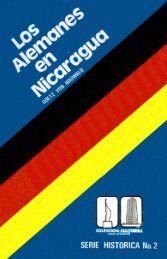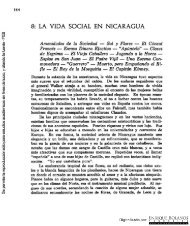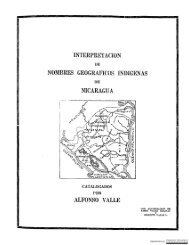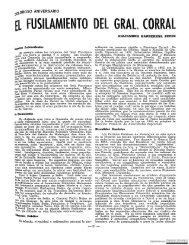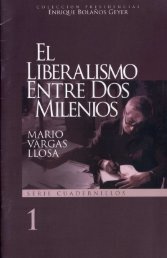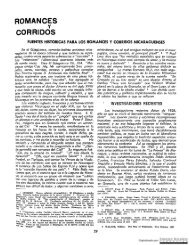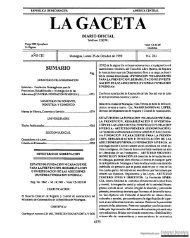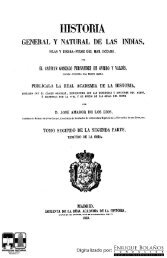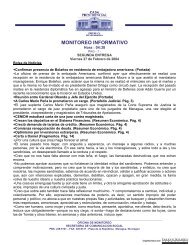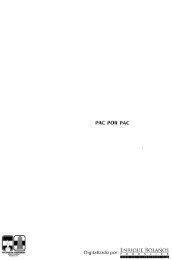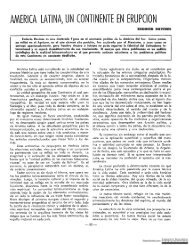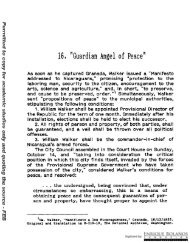4. A Great Change Has Come - Biblioteca Enrique Bolaños
4. A Great Change Has Come - Biblioteca Enrique Bolaños
4. A Great Change Has Come - Biblioteca Enrique Bolaños
Create successful ePaper yourself
Turn your PDF publications into a flip-book with our unique Google optimized e-Paper software.
<strong>4.</strong> A <strong>Great</strong> <strong>Change</strong> <strong>Has</strong> <strong>Come</strong><br />
The vanguard of the Forty-Niners via San Juan de Nicaragua<br />
--two passengers-- sailed from New York aboard the brig<br />
Frances on January 4th, 1849. The next contingent, 116<br />
strong, left New York on the brig Mary on February 18, and<br />
landed at San Juan on March 11. By the fall of 1850,<br />
two-thousand travellers had crossed Nicaragua, to and from<br />
California, and ever larger numbers kept coming.<br />
From San Juan, the argonauts sailed In native bungos one<br />
hundred and eighty miles up the San Juan river and Lake<br />
Nicaragua to Granada. Then they rode one hundred and fifty<br />
miles on horseback or In a clumsy carreta, a two-wheeled<br />
oxcart covered with raw-hides, stopping at Masaya, Managua,<br />
Le6n, Chlchlgalpa, Chlnandega, and Intermediate villages,<br />
until they reached Realejo, on the Pacific. With normal delays<br />
along the way, they frequently spent over a month, and at<br />
times much longer, on Nicaraguan soil.<br />
The california gold rush opened a new era In Nicaragua.<br />
One day In November, 1850, thirty-seven vessels crowded the<br />
port of Realejo, chiefly from San Francisco. Four transportation<br />
companies competed to forward passengers through, from<br />
one ocean to the other. The amount of land under cultivation,<br />
In 1850, far exceeded that of any previous year since<br />
Independence from Spain. Indigo, sugar, and coffee production<br />
were expected to rise 30 to 50 per cent. The corn crop<br />
doubled that of 1849.<br />
Nicaraguans received the california travellers with open<br />
arms. The people were "kind and obliging. " 1 The government<br />
1 "our Central Alterican Correspondence," NY ll•rald, 11/25/50, p4, c2.
48 WILLIAM WALKER<br />
was also very friendly to Americans, making land grants to<br />
those who requested them, and about a hundred Americans<br />
opened establishments along the route; among these, the<br />
agents of several california houses trading In coffee, sugar,<br />
rum, rice, and other tropical products. American hotels<br />
appeared In Granada, Le6n, Realejo, and other cities. Americans<br />
obtained a grant to construct a plank road from Realejo<br />
to the mouth of the harbor. But the canal company put an end<br />
to that Incipient activity towards development.<br />
During the negotiations of the Clayton-Bulwer treaty,<br />
Joseph L. White promised Sir Henry Bulwer that an equal<br />
participation In the canal Company would be offered to<br />
British capitalists on reasonable terms. Several months later,<br />
White and Vanderbilt went to London, armed with "strong<br />
letters" from Sir Henry, and effected "an eminently satisfactory<br />
arrangement with British capitalists, by which the latter<br />
agreed, under certain conditions, to subscribe half the capital<br />
for the enterprise. " 2 The conditions were: substantiate your<br />
statements by facts; show that the project will be profitable.<br />
To obtain the needed facts, the Company was already<br />
making a scientific study of the route. It engaged a corps of<br />
fifteen engineers headed by Colonel Orville W. Childs, Chief<br />
Engineer of the State of New York, who had recently completed<br />
work on the enlargement of the Erie canal. Vanderbilt<br />
instructed Childs to locate the most feasible line for the<br />
interoceanic canal, to survey it, and to present an estimate<br />
of the cost of the work. When the corps of New York engineers<br />
and their ""boxes of mathematical instruments'' arrived<br />
in Rivas In August, 1850, Nicaraguans were enthralled,<br />
erroneously believing that they came not to ascertain the<br />
practicability of the building of the canal, but to make the<br />
actual surveys, and lay down the route. 1<br />
z,.Tbe Nicaragua tanal--Qperationa in London--Critical State of the<br />
Canal eo.pany•• Charter," Ibid. 11/16/1850, p.2, c.3; "Opinion of British<br />
Capitalists," Ibid. 12/3/1852, p.2, c.S.<br />
3 "tanal de Nicaragua," Correo d•l lstao, 9/9/1850, p.3, c.3.
A GREAT CHANGE HAS COME 49<br />
Vanderbilt Instructed Childs to simultaneously construct<br />
a transit road In the Isthmus of Rivas for the Immediate use<br />
of California travellers, and the COmpany sent steamboats to<br />
navigate the San Juan river and Nicaragua Lake. The 120 tons<br />
Director, with a capacity for 400 passengers, was the first<br />
steamer ever to pass the river rapids and navigate on Lake<br />
Nicaragua. Its arrival at Granada on January 1st, 1851, was<br />
dutifully chronicled by Prefect Fermfn Ferrer In a historical<br />
message to the Government at Le6n:<br />
Today, the first day of January, 1851, a new era<br />
dawns for Nicaragua, already on her way to a future of<br />
prosperity and happiness. --At sunrise in this memorable<br />
and joyful day, the steamer Director appeared,<br />
cutting through the waters of the lake towards the city<br />
••• This beautiful vessel brought the Central American<br />
flag on her bow, and the North American flag abaft,<br />
saluting each other •••<br />
The entire population of Granada thronged to the<br />
beach, and dizzy with delight admired for the first time<br />
this ingenious mechanism developed in the present<br />
century, The obstacles of the river have been conquered<br />
by human skill, and a mysterious coincidence has<br />
brought the steamer Director to our shores on this day,<br />
to herald to us that the happiness and fortunes of<br />
Nicaragua date from January 1st, 1851, the first day of<br />
the second half of the nineteenth century. 4<br />
The parish priest, Father Agustin Vijll, merrily rang all<br />
the church bells In town, exulting: "A vessel that comes from<br />
the shores of Washington. Happy day, happy year, happy era,<br />
happy forever, Granada!" 5 Far were the people of Granada<br />
from Imagining that the Director was a herald of doom; nor<br />
4 "Jotereaante,• Ibid. 1/1/1851, p.3 c.2.<br />
5 Ibid.
50 WILLIAM WALKER<br />
could Father Vljll and Prefect Ferrer foretell their own<br />
relevant roles In the forthcoming tragedy that culminated In<br />
the total destruction of their city In November, 1856. That was<br />
unthinkable In January, 1851, when the American Atlantic and<br />
Pacific Ship canal Company was ready to Initiate Its transit<br />
operations In Nicaragua.<br />
Another steamboat, the Orus, renamed Nicaragua,<br />
foundered on the Machuca rapids, about sixty miles upriver<br />
from San Juan. It went "high and dry• on the 9th of<br />
November, 1850. The Bulwer replaced It, while COl. Childs and<br />
his crew cut a road through the wilderness In the Isthmus of<br />
Rivas, between the lake and the Pacific. on August 14, 1851,<br />
the New York Herald published a very favorable report about<br />
the first crossing of the new route, calling It •equivalent to<br />
the Introduction of another epoch In the history of our<br />
Inter-oceanic communications with california, and the Pacific<br />
Islands, and the eastern hemisphere. ··•<br />
The steamship Pacific sailed from San Francisco July 14th<br />
and landed her passengers at san Juan del Sur on the 29th.<br />
They crossed on muleback over the yet unfinished road to<br />
VIrgin Bay, on the lake shore. The Director took them across<br />
the lake and down river to the Castillo rapids. The Bulwer<br />
carried them from the rapids to san Juan del Norte, setting<br />
a new record of thirty-four-and-a-half hours for the whole<br />
running time from the Pacific to the Atlantic ocean. When the<br />
Prometheus landed the 360 passengers at New York on August<br />
12, they had made the voyage from San Francisco In 29 days<br />
and 5 hours, beating on the first try the shortest time ever<br />
made over the Panama route, which was 31 days.<br />
Passengers crossing from east to west shared a totally<br />
different experience. They were detained three weeks In<br />
Rivas, "among the vermin, filth and disease of Nicaragua,·<br />
while the Pacific made a side run to Panama. 7 Upon their<br />
1 "Tbe Nicaragua 'loute--Succeasful Enterprise," lfTB, 8/1•1/51, pt, cl.<br />
'''!be YaDderbilt Route," Alta, 8/31/1851, p.2 c.S; p.3 c.2.
A GREAT CHANGE HAS COME 53<br />
Nicaraguans stili friendly to the United States expressed<br />
it with vehemence: "0 true spirit of great Taylor! do not<br />
permit Nicaragua to repent having followed your advice. No!<br />
a thousand times no!"" 13 General Jose Trinidad Muf'loz, head of<br />
the Nicaraguan Army, was despondent: "I hope in Heaven I am<br />
mistaken, but, In the descent of General Taylor to the grave,<br />
I cannot resist the feeling that the glorious perspective<br />
which had opened for Nicaragua has vanished forever. " 14<br />
The fact of the matter is that on the first anniversary of<br />
the Clayton-Bulwer treaty, England seemed to enjoy a clear<br />
field In Central America. The liberal forces of El Salvador,<br />
Nicaragua, and Honduras that Squier had championed, under<br />
Taylor, were forsaken by the Fillmore administration. The<br />
British retained possession of San Juan de Nicaragua with the<br />
tolerance and apparent support of American Secretary of<br />
State, Daniel Webster. The tide of friendship that filled<br />
Nicaraguan hearts in 1849, was on the verge of turning into<br />
a deep hatred for the United States in 1851.<br />
To worsen matters, the canal bubble was beginning to<br />
burst as the New York corps of engineers concentrated on<br />
the task of opening a transit road in the isthmus of Rivas.<br />
Col. Childs' initial survey made it clear from the beginning<br />
that no canal was to be built in the foreseeable future. His<br />
findings showed that the work was not practicable for the<br />
maritime needs of the 1850's.<br />
Childs' final proposal, advanced in a detailed report in<br />
1852, envisioned a canal for vessels drawing 17 feet of water,<br />
at an estimated cost of $31,538,319.55. In order to admit ships<br />
of 25 ft draught, the cost soared above one hundred million<br />
dollars. When the matter was submitted to the capitalists in<br />
London, no one was found willing to invest in the canal.<br />
Commodore Vanderbilt visited Nicaragua in January, 1851,<br />
and spent some time with Col. Childs in Rivas. On his return<br />
13 "Hicarasua and the United Statea," Ibid. 6/3/1851, p.?, o.2.<br />
14 "Very Late and I•portant fro. Nicaragua," Ibid. • 1/31/1851, p2 c3.
54 WILLIAM WALKER<br />
to the United States, he was "sanguine that a speedy and<br />
expeditious transit will be opened ••• the motto Is go ahead, •<br />
but "the great question of the ship canal" he left for the<br />
future. 15 With the long experience and business acumen of a<br />
shipping magnate, Vanderbilt appreciated that the transit<br />
was the most profitable and feasible part of the venture.<br />
COnsequently, when the transit operations were about to<br />
begin, It became expedient to separate from the Canal<br />
Company grant the part relating to the navigation by steam<br />
of the waters of Nicaragua, and form a different company to<br />
run the transit route.<br />
Around that time, rumors from Nicaragua asserted that the<br />
Government was planning to annul Its contract with the Ship<br />
Canal Company at the onset of the oncoming Legislative<br />
sessions In Managua; moreover, several other companies were<br />
on the field, lobbying to obtain the privilege of navigation by<br />
steam on the San Juan river and Lake Nicaragua.<br />
Joseph L White again used his political connections, and<br />
the state Department aided him once more In the spring of<br />
1851 when It appointed John Bozman Kerr Charg6 d'Affaires<br />
to Nicaragua. Secretary of State Daniel Webster Instructed<br />
Kerr to spare no proper efforts "to uphold the transit<br />
company In Its just rights, on which such large expenditures<br />
have been made." 18 Webster then named Loomis L. White,<br />
Joseph's younger brother, u.s. COnsul In San Juan del Sur.<br />
Kerr salted from the New York aboard the Prometheus on<br />
June 4, 1851, bound for his new post In Nicaragua. Joseph L<br />
White followed him on the next trip of the vessel, a month<br />
later.<br />
15 "our Nicaragua Correspondence," Ibid., 2/27/1851, p.2, c.<strong>4.</strong><br />
11 John Bozaan Kerr to Daniel Webster (Le6n, Karch 15, 1852),<br />
Kicrofit. Publication KZ19-9, National Archives, Waabington, D.C.



